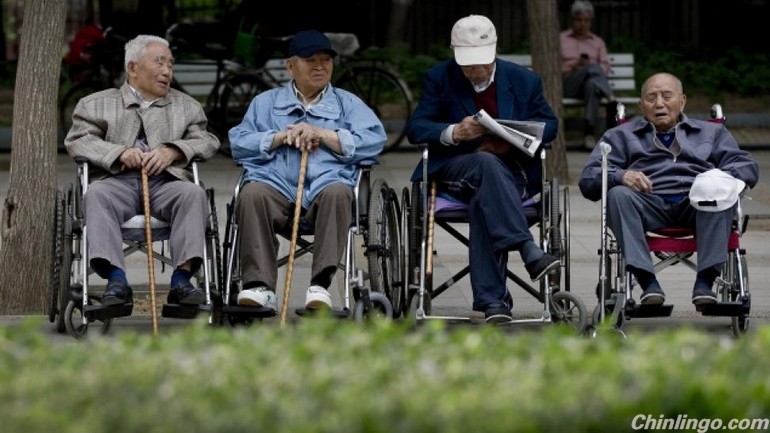China is becoming an ageing society. But, unlike other ageing societies such as Japan and Germany, it is getting old when its income is still relatively low. In terms of the share of old people in the population, China today looks like Japan at the end of 1980s, but in terms of per-capita gross domestic product, it has just reached the level of Japan in the early 1970s. Japan started more than 20 years of stagnation in the early 1990s, and many people fear that China will follow its footsteps in the next 10 to 20 years.
中国正步入老龄化社会。但和日本和德国等其他老龄化社会不同,中国在收入还相对较低的时候就开始老龄化了。就老年人占总人口比例而言,当下的中国就像是上 世纪80年代末的日本,但就人均国内生产总值(GDP)而言,中国才刚刚达到日本在上世纪70年代初的水平。日本在上世纪90年代初开始了持续20多年的 停滞,许多人担忧中国将在接下来的10到20年里重蹈日本的覆辙。
China's demographic structure was almost the same as India's until late 1970s when China started to enforce a stringent family planning policy. Since then its demographic transition has been very abrupt. The proportion of people over 60 years old is now more than 12 per cent of the population and those of working-age, between 16 and 65 years old, has begun to decline by 2.5m a year. Furthermore, labour movement from the countryside to the city, which used to be a major source of growth in China, is drying up. According to the official numbers, agriculture still employs 30 per cent of China's total labour force. But most economists, such as Cai Fang, one of the most prominent economists on labour issues, believe that the real number is much smaller. The average farm is tiny — only about one hectare — so most farmers have to take additional jobs outside the farming sector to sustain a decent living.
过去中国的人口结构几乎和印度相同——直到中国在上世纪70年代后期开始推行严格的计划生育政策。其后中国的人口结构转变非常剧烈。现在60岁以上人口已 经超过了总人口的12%,而劳动年龄人口,也就是16到65岁之间的人口每年下降250万人。此外,曾经推动中国经济增长的从农村到城市的劳动力流动,正 在逐渐枯竭。根据官方数据,农业依然雇佣了中国30%的劳动力。但大多数经济学家(包括劳动力问题研究方面最知名的经济学家之一蔡昉)相信真正的比例要小 得多。一般的农地很小,大概一公顷左右,因此大多数农民不得不在务农以外从事额外的工作,才能维持像样的生活。
The official data on urbanisation are also problematic. These figures only count people living in government-designated cities as urban dwellers. So, while many villages in coastal provinces have become industrial towns, their inhabitants are still counted as rural dwellers. In recent years, employment growth in coastal provinces has been stagnant. The number of migrant workers has even declined in 2015. Although rural-to-urban labour movement will continue in inland provinces, thanks to the government's policy aim to move 100m people into the city, it is unlikely to be a major driver for China's overall growth.
官方的城镇化数据也问题重重。这些数据只将在政府指定城市居住的人算作城市居民。因此,尽管许多沿海省份的村子已变成工业城镇,但那里的居民依然被算作农 村居民。近年来,沿海省份的就业增长陷入停滞。农民工的数量在2015年甚至还下降了。尽管受政府促进约1亿农业转移人口落户城镇的政策目标推动,内陆省 份从农村到城市的劳动力流动将会持续,但这种流动不太可能成为中国总体增长的主要驱动力。
The first is to postpone retirement. The current retirement ages were set in the early 1950s. They allow blue-collar female workers to retire at 50, and blue-collar male workers at 55. This means that most women can enjoy a pension for 30 years, probably longer than they have worked for. The sixth National Census (these happen every ten years) conducted in 2010 shows that women's labour-force participation rate dropped by 20 percentage points at 50. A sensible policy is gradually to raise the retirement ages until they uniformly reach 60.
中国能够采取的第一项措施是延迟退休。目前的退休年龄是在上世纪50年代初设定的,允许蓝领女性劳动者在50岁时退休,蓝领男性劳动者在55岁时退休。这 意味着大多数女性可以领取30年的养老金,很可能比她们的工作时间还长。2010年的第六次全国人口普查(每十年一次)表明,到50岁时,女性的劳动力参 与率会下降20个百分点。明智的政策是逐步提高退休年龄,直到将男女退休年龄统一为60岁。
The second thing China can do is continue to raise the educational level of its young people. Currently, less than 40 per cent of young people go to college. While an average young adult in the city can almost always finish high school (having had 12 years of education), his rural counterpart — including migrant workers in the city — barely finishes middle school (nine years of education). The return on education is quite high; one more year of formal education can raise a person's wage by 10 per cent. On average, people in their 20s have had 4.3 more years of education than people in their 50s.
第二项措施是继续提高年轻人的教育水平。目前只有不到40%的年轻人上大学。尽管城市的一般年轻人几乎都能完成高中学业(12年教育),但农村年轻人(包 括进城务工的农民工)能完成初中学业(9年教育)就算不错了。教育的回报很高:一个人每多接受一年的正规教育,薪资就能提高10%。平均而言,20多岁的 人比50多岁的人多接受4.3年的教育。
The third thing is to strengthen research and development. Both Japan and South Korea became world technology leaders after they reached China's per-capita income of today. This, of course, does not guarantee that China can do the same, but the signs are that it is on the right track. Thanks to its miraculous growth, China has accumulated a huge amount of wealth. As a result, it can afford to increase its R&D spending -and fast. Last year, R&D spending reached 2.1 per cent of GDP; by 2020, it will certainly reach 2.5 per cent, higher than in many advanced countries.
第三项措施是加强研究和开发。日本和韩国在人均收入达到当今中国的水平后成为了世界技术领袖。当然,这并不能保证中国也能做到同样的事情,但有迹象表明, 中国已经走上了正确的轨道。得益于奇迹般的增长,中国积累了大量财富。因此,中国能够快速提高研发支出。去年,中国的研发支出达到了GDP的2.1%;到 2020年,中国的研发支出肯定能达到GDP的2.5%,高于许多发达国家。
The reforms initiated by Premier Li Keqiang have created a vibrant financial sector that channels money to support innovation; private equity and venture capital companies are flourishing. As a result, private R&D spending is now higher than that by the government.
中国总理李克强发起的改革,已建立了一个富有活力的金融业,引导资金支持创新;私人股本和风险投资公司正在蓬勃发展。其结果是,私人部门的研发支出如今高于政府投入。
So, while ageing is taking a toll on China's growth, it will be balanced in the next 10-15 years by improvements in education and technological capacity as well as policy adjustment on retirement ages. China's real demographic challenge will only come between 2025 and 2030, when there will be little room left for improvement in education, R&D spending will be likely to plateau, and the baby boomers of the 1960s will have all left the labour force — even if retirement ages are pushed back.
因此,尽管老龄化正在损害中国的增长,但在接下来的10到15年,教育程度和技术能力的提高,以及退休年龄的政策调整,将平衡老龄化带来的影响。中国真正的人口结构挑战将在2025到2030年间来临,到那个时候,教育已没有多少改善空间,研发支出已进入平台期,上世纪60年代婴儿潮时期出生的人已全部离开劳动力队伍——即使退休年龄推后也是如此。
To better prepare for that period, it is probably time for China to give up its family planning policy. The one-child policy was introduced in 1979: the birth rate in the country was 25m in 1987, 20m in 1997 – and 16m last year.
要更好地为那个时期做准备,现在很可能是时候放弃计划生育政策了。一胎化政策1979年出台:1987年中国的出生人口为2500万,1997年为2000万,而去年已降至1600万。




 闽公网安备 35020302035673号
闽公网安备 35020302035673号
0 responses on "3 measures to tackle China's ageing problem"